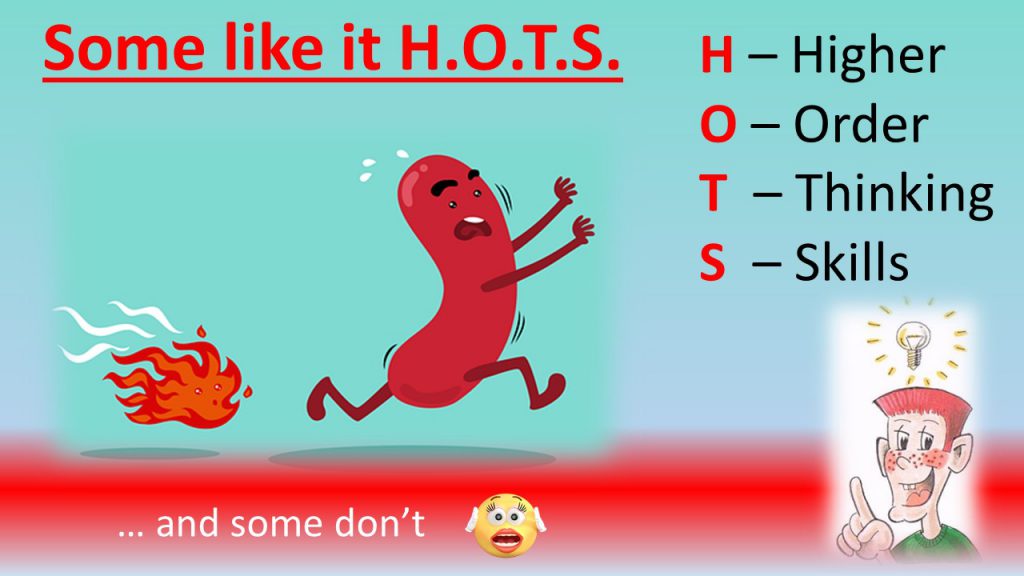
HOTS

מה זה .H.O.T.S
What are H.O.T.S.
כל התלמידים הניגשים ל4 או 5 יחידות בגרות באנגלית חייבים להכיר ולדעת להשתמש במיומנות חשיבה הבאות.
להן 15 מיומנות חשיבה שצריכים לדעת:
All pupils studying for the 4 or 5 point Bagrut in English must be aware of these 15 thinking skills required for the Literature Bagrut Modules.
Thinking Skill שם של מיומנות חשיבה | Students will be able to: תלמידים יצטרכו לדעת איך | Sample Tasks/Questions דוגמאות |
1Predictingלצפות | Predict the content or the outcome of the text, either before or during reading based on available information. | ·How do you think ___ will react? · How do you think the story will end? |
2 Applying ליישם | apply previously learned concepts, terms, techniques and skills to new situations. | · How can you apply ___ to your own life? · How can you apply ___ to something else you have learned? |
3 Inferring לְהַסִיק | infer implicit meaning from the text by being able to read-between-the-lines.
| · What do you think the character meant when s/he said, “___”? What does ___’s behavior suggest? What is the purpose or function of this information? · What different meanings can be inferred from this line in the poem? |
4 Sequencing רצף | explain how the sequence of events in a text, when not in a chronological order, affects understanding of the text. | · Sequence the events in chronological order. · How do flashbacks affect your understanding of the text/plot? · Why do you think the events are not in chronological order? |
5 Identifying parts and whole זיהוי חלקים ושלמים | explain how the parts function together within the whole text. | ·How does one part of the story contribute your understanding to the whole text? ·How does the title/ending relate to different parts of the story/poem/play? · What does the rhyme scheme of the poem contribute to the whole poem? |
6 Classifying סיווג | categorize the elements of the text according to criteria. | · Categorize the characters according to their relationships/values. |
7 Comparing and contrasting השוואה והנגדה | find similarities (comparing) and differences (contrasting) and draw conclusions. | · Compare and contrast the conflicts/ problems/dilemmas in two stories or poems. · Compare and contrast the text and the film. · Compare and contrast characters in a text. |
8 Explaining patterns להסביר דפוסים | identify and explain different patterns in the text and explain their significance. | · Explain why certain lines/phrases/words are repeated. · What behavior does the character repeat? · Where is the rhyme scheme of the poem broken and why?
|
9 Explaining cause and effect הסבר על הסיבה וההשפעה | describe and explain the causal relationships between actions or events in a text. | · What were the results of ___‘s action? · What caused ___ to think that ___? |
10 Distinguishing different perspectives הבחנה בין נקודות מבט שונות | identify the different perspectives within the text and/or among the readers of the text. | · Identify how different characters respond to a central event in the story. · How does your understanding of the characters’ actions/events in the story change as you read? · Do you share the same perspective as the narrator? Explain. · How does your understanding of the story/the character/the scene differ from other students in your class? |
11 Problem Solving פתרון בעיות | identify a problem/dilemma and either identify its solution in the text or suggest a possible solution, taking into account the constraints and the options present in the text. | · Define the problem facing the protagonist. · How should ___ decide what to do? · What should ____ take / have taken into account? · What is the central conflict in this text and how is it resolved? Explain. · What dilemma does ___ face at this point in the story? |
12 Uncovering motives לחשוף מניעים | identify motives that explain the character’s behavior and support this with evidence from the text. | · Why do you think that __ did __? Support your answer. · What made ___ change his/her mind? Give supporting details. |
13 Generating possibilities יצירת אפשרויות
| create something new on the basis of what is understood from the text. | · Create a new character for the story. · Explain how s/he will affect the development (or outcome) of the story. · Generate possible options for characters/plot outcomes/sequels or prequels. · Add an element/an event to the existing text that influences the development and/or the outcome of the plot. |
14 Synthesizing סינתזה | integrate different aspects of/insights to the text. | · Write a summary of the story. · How does information we learn later in the text change the way we understand a character/issue/conflict? |
15 Making connections עשיית קשרים | make connections between specific aspects of the text. make connections between the text and other contexts in relation to historical, and cultural contexts or pertinent information from the author’s biography. | · How does the description of the setting connect to the characterization of __? · To what extent do events in the text reflect events in the life of the author? ·How does your understanding of the story/the character/the scene differ when you learn about a topic related to the literary text? |
Evaluating הערכה
| make judgments about different aspects of the text and justify opinions and/or evaluate someone else’s opinion. | · What makes this a good story? Explain. · Is ___ a believable character? Explain. · Is the resolution of the conflict satisfying? Explain. |

